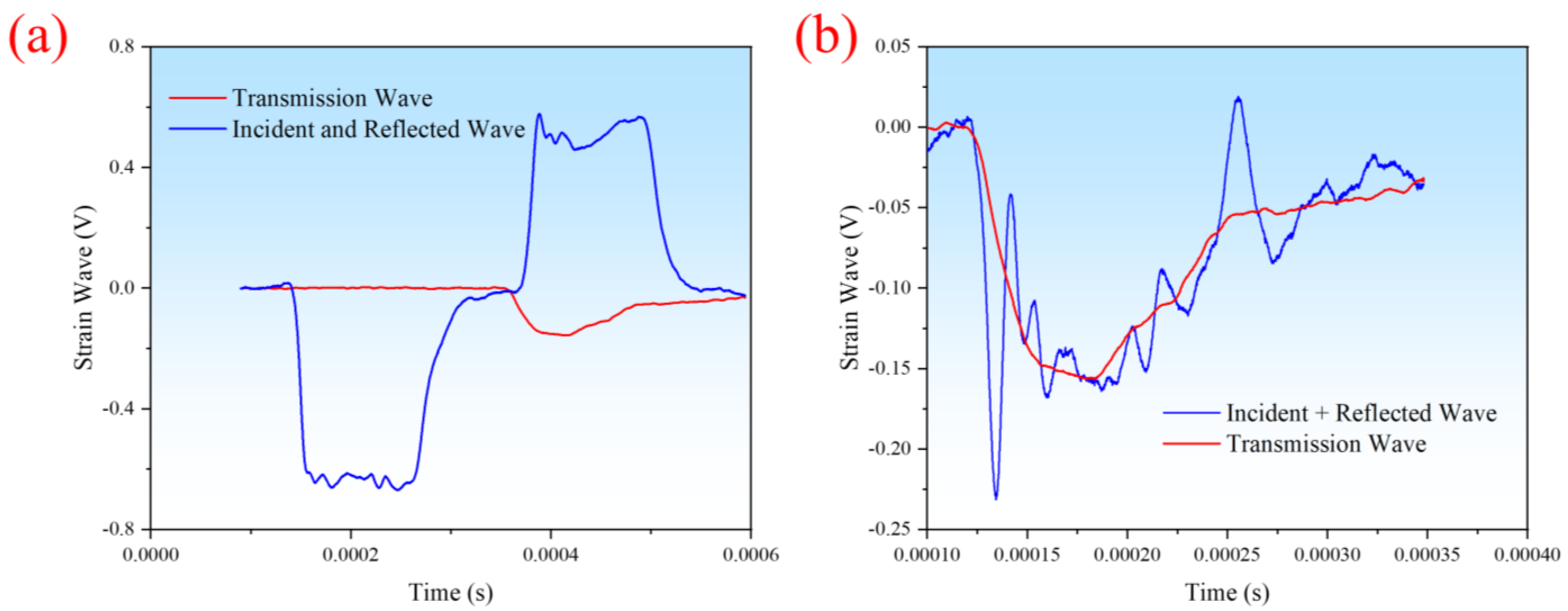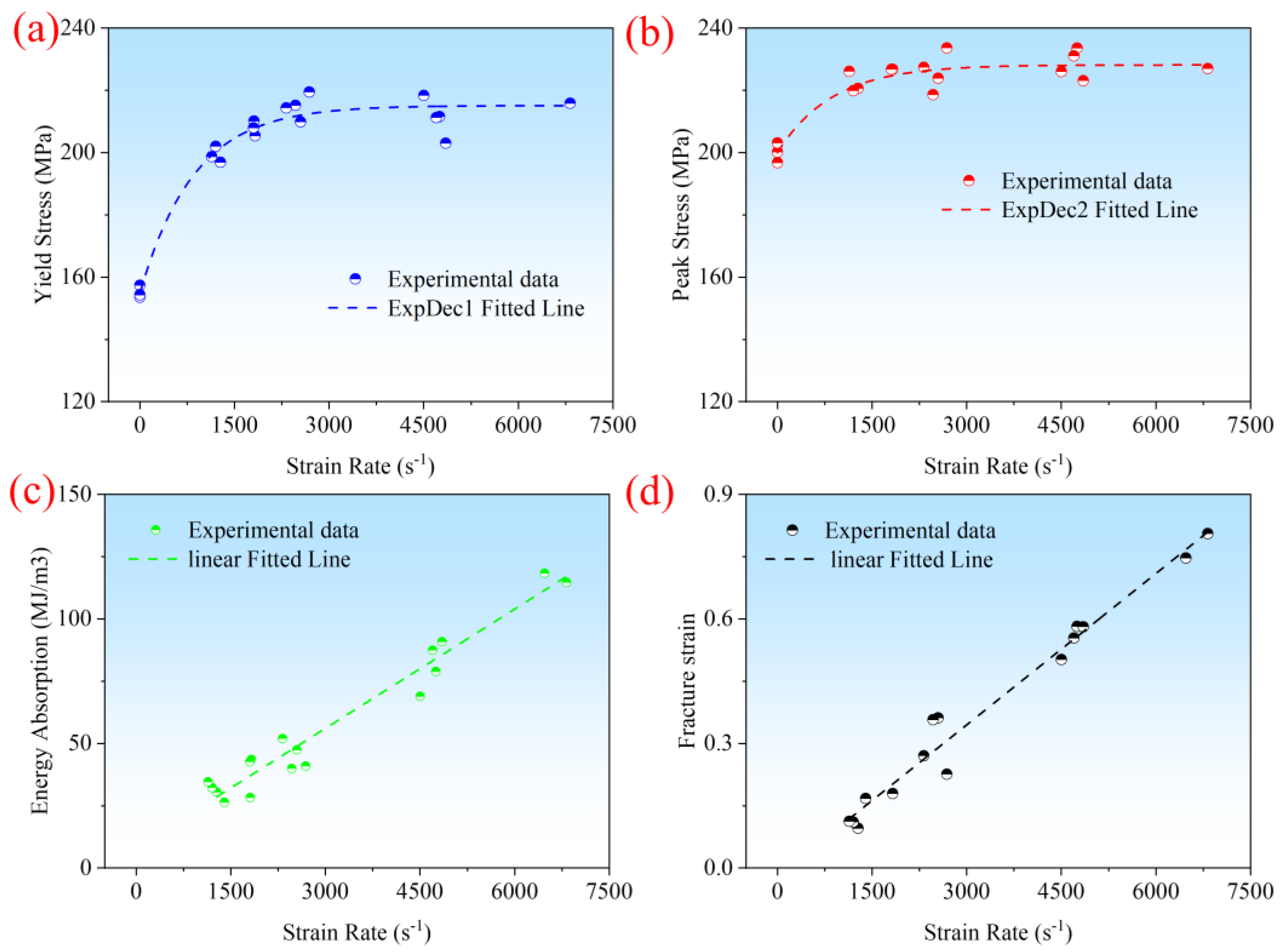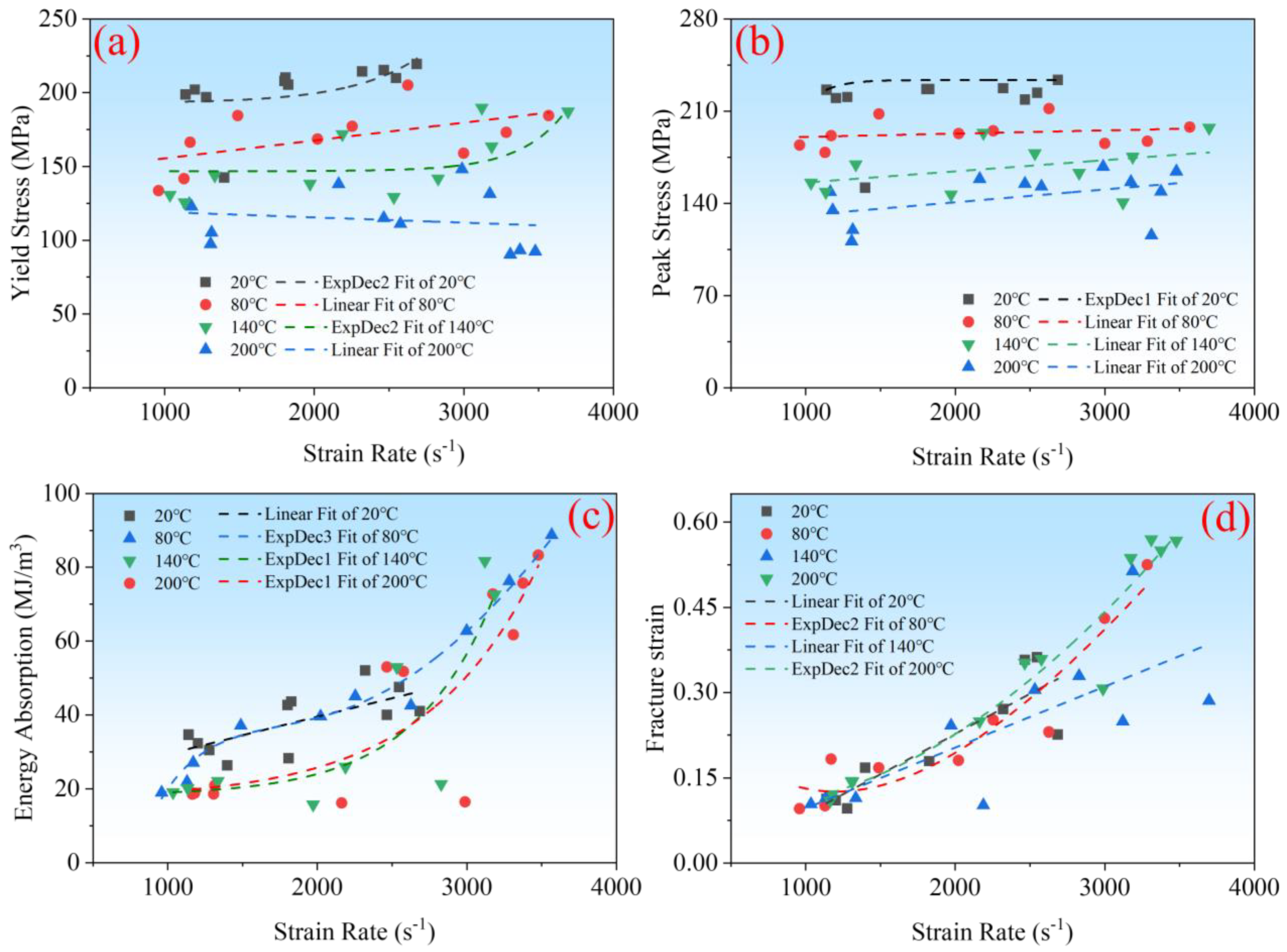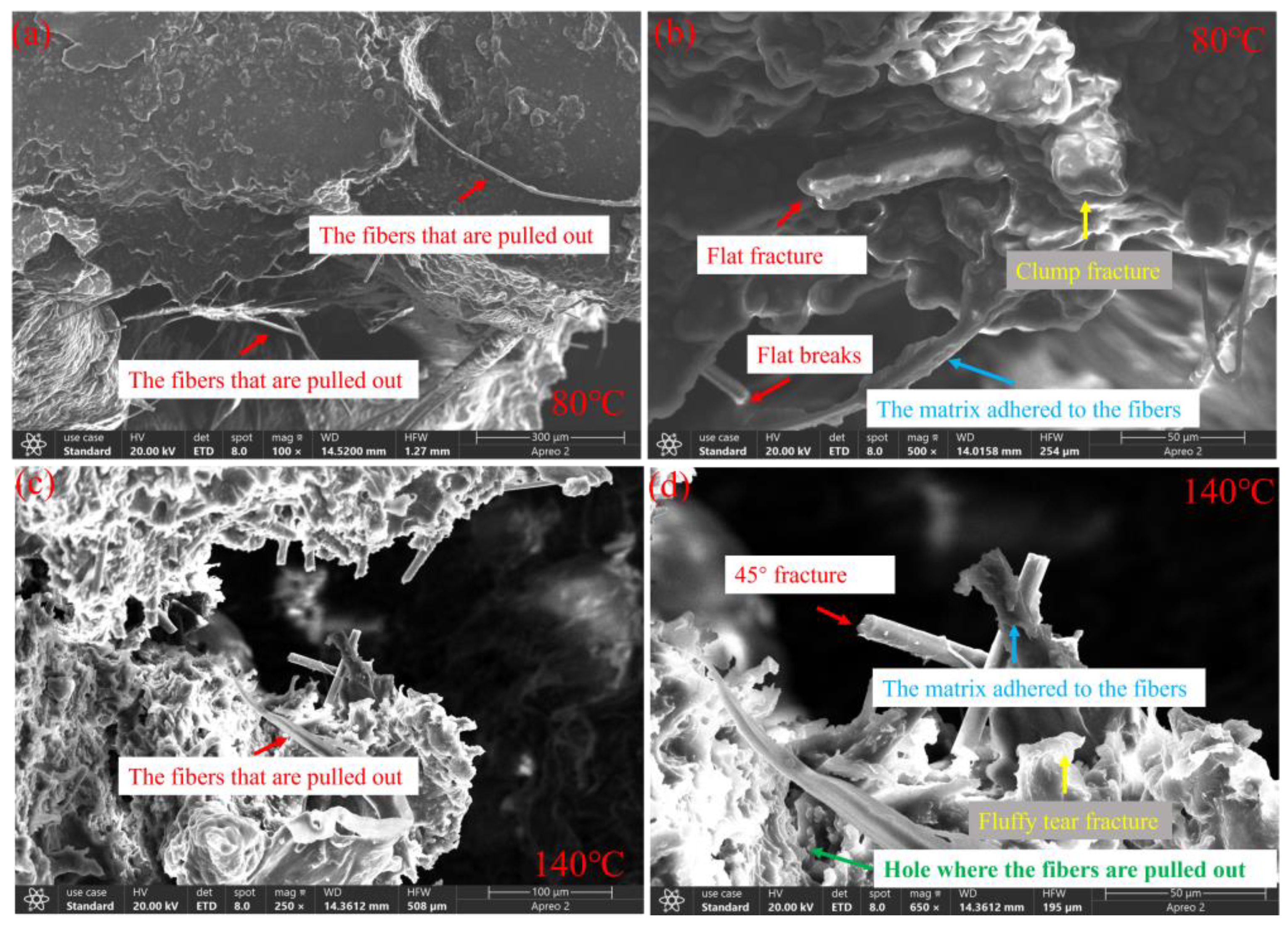An Experimental Study on the Thermomechanical Coupling Effects of Carbon-Fiber-Reinforced Polyetheretherketone under Dynamic Impact
Abstract
1. Introduction
2. Experiment
2.1. Materials and Specimens
2.2. Experimental Setup
3. Results and Discussions
3.1. Influence of Temperature on Mechanical Properties
3.2. Influence of Strain Rates on Mechanical Properties
3.3. Coupling Effects of Temperature and Strain Rate
3.4. Microdamage Mechanisms
4. Conclusions
- (1)
- As the temperature increases, the yield strength, peak stress, and specific energy absorption of CF/PEEK decrease, while the fracture strain does not show significant changes.
- (2)
- With an increase in the strain rate, the yield strength, peak stress, specific energy absorption, and fracture strain all exhibit strain-hardening effects. However, as the strain rate further increases, above 4000 s−1, the enhancing effect of strain rate on the yield strength and peak stress becomes less pronounced.
- (3)
- The temperature and strain rate have a coupling effect on the high-speed impact mechanical properties of CF/PEEK. The strain rate has an enhancing effect on the yield strength, peak stress, specific energy absorption, and fracture strain. As the temperature rises, the strain-hardening effect on the yield strength weakens, while the strain-hardening effect on the specific energy absorption is enhanced.
- (4)
- The analysis of microscopic damage mechanisms reveals that compared to dynamic compression, static compression results in more interfacial debonding and sliding phenomena between the fiber and the matrix, leading to reduced stress transfer efficiency and thus making the peak stress highly sensitive to the strain rate. The increase in temperature causes the PEEK matrix to soften, enhancing viscoelastic behavior, which in turn affects the material’s toughness and stress transfer mechanism.
Author Contributions
Funding
Institutional Review Board Statement
Data Availability Statement
Conflicts of Interest
References
- Zhang, J. Molding Process and Properties of Polyimide-Fiber-Fabric-Reinforced Polyether Ether Ketone Composites. J. Polym. Eng. 2022, 42, 904–913. [Google Scholar]
- Li, S. Dynamic Mechanical Analysis of Continuous Carbon Fiber-Reinforced Polyetheretherketones under Multi-Consecutive Temperature Scans. Polym. Compos. 2022, 43, 6013–6024. [Google Scholar] [CrossRef]
- Zhao, W. The Influence of Long Carbon Fiber and Its Orientation on the Properties of Three-Dimensional Needle-Punched CF/PEEK Composites. Compos. Sci. Technol. 2021, 203, 108565. [Google Scholar] [CrossRef]
- Ma, X.L.; Wen, L.H.; Wang, S.Y.; Xiao, J.Y.; Li, W.H.; Hou, X. Inherent Relationship between Process Parameters, Crystallization and Mechanical Properties of Continuous Carbon Fiber Reinforced PEEK Composites. Def. Technol. 2023, 24, 269–284. [Google Scholar] [CrossRef]
- Gaitanelis, D.; Worrall, C.; Kazilas, M. Detecting, Characterising and Assessing PEEK’s and CF-PEEK’s Thermal Degradation in Rapid High-Temperature Processing. Polym. Degrad. Stab. 2022, 204, 110096. [Google Scholar] [CrossRef]
- Almeida, O.D.; Feuillerat, L.; Fontanier, J.-C.; Schmidt, F. Determination of a Degradation-Induced Limit for the Consolidation of CF/PEEK Composites Using a Thermo-Kinetic Viscosity Model. Compos. Part A Appl. Sci. Manuf. 2022, 158, 106943. [Google Scholar] [CrossRef]
- Andrew, J.J.; Alhashmi, H.; Schiffer, A.; Kumar, S.; Deshpande, V.S. Energy Absorption and Self-Sensing Performance of 3D Printed CF/PEEK Cellular Composites. Mater. Des. 2021, 208, 109863. [Google Scholar] [CrossRef]
- Tang, Z.; Chen, C.; Li, A.; Deng, Y.; Zhang, C.; Li, Y. Temperature- and Strain-Rate-Dependent Tensile Failure Behavior of Short-Fiber-Reinforced PEEK Composites. Compos. Part B Eng. 2023, 250, 110455. [Google Scholar] [CrossRef]
- Pan, Z.; Yang, C.; Huang, S.; Wang, M.; Wu, Z.; Gu, B. High Strain-Rate Compression Behavior of Woven CF/PEEK Thermoplastic Composites at the Glassy State and High-Elastic State. Int. J. Mech. Sci. 2022, 235, 107740. [Google Scholar] [CrossRef]
- Berer, M.; Major, Z.; Pinter, G.; Constantinescu, D.M.; Marsavina, L. Investigation of the Dynamic Mechanical Behavior of Polyetheretherketone (PEEK) in the High Stress Tensile Regime. Mech. Time-Depend. Mater. 2014, 18, 663–684. [Google Scholar] [CrossRef]
- Lei, M.; Hamel, C.M.; Chen, K.; Zhao, Z.; Lu, H.; Yu, K.; Qi, H.J. Thermomechanical Behaviors of Polyether Ether Ketone (PEEK) with Stretch-Induced Anisotropy. J. Mech. Phys. Solids 2021, 148, 104271. [Google Scholar] [CrossRef]
- Sun, Q.; Wen, X.; Yin, G.; Jia, Z.; Yang, X. Thermodynamic Coupling Forming Performance of Short Fiber-Reinforced PEEK by Additive Manufacturing. Polymers 2024, 16, 1789. [Google Scholar] [CrossRef]
- Lifshitz, J.M.; Leber, H. Data Processing in the Split Hopkinson Pressure Bar Tests. Int. J. Impact Eng. 1994, 15, 723–733. [Google Scholar] [CrossRef]
- Iwamoto, T.; Yokoyama, T. Effects of Radial Inertia and End Friction in Specimen Geometry in Split Hopkinson Pressure Bar Tests: A Computational Study. Mech. Mater. 2012, 51, 97–109. [Google Scholar] [CrossRef]
- GB/T 34108-2017; Metallic Materials-High Strain Rate Compression Test Method at Ambient Temperature. Standardization Administration of China: Beijing, China, 2017.
- GJB 5982-2007; Test Method for the Mechanical Properties of Engineering Plastics—Dynamic Compression. Commission of Science, Technology and Industry for National Defence: Beijing, China, 2007.
- Santos, S.M. High-Temperature Thermal Transport Properties of Multifunctional PTFE/PEEK-Matrix Composite With Short Carbon Fibers and Graphite Flakes. J. Eng. Mater. Technol.-Trans. ASME 2022, 144, 041003. [Google Scholar]
- Kumar, S. Shape Memory Behavior of 4D Printed CF/PEKK High Temperature Composite under Subsequent Thermomechanical Cycles. Mater. Lett. 2024, 366, 136567. [Google Scholar]
- Nie, S.; Wang, J.; Chen, L.; Du, B.; Pan, X.; Guo, Y.; Deng, J. Mechanical Response and Damage Evolution of CF / PEEK -reinforced Al Metal-composite Hybrid Structure at High Strain Rate. Polym. Compos. 2024, 45, 9543–9560. [Google Scholar] [CrossRef]
- Xu, X.; Deng, J.; Nie, S.; Lan, Z.; Xu, Z. Effect of Thermal Aging on Mechanical Properties and Morphology of GF/PBT Composites. Polymers 2023, 15, 3798. [Google Scholar] [CrossRef]
- Cao, J. Evaluating the Loading Rate Dependency of Mode I Delamination for Composite Laminates at Different Temperatures. Compos. Sci. Technol. 2024, 249, 110505. [Google Scholar] [CrossRef]
- Liu, A.; Chen, Y.; Hu, J.; Wang, B.; Ma, L. Low-Velocity Impact Damage and Compression after Impact Behavior of CF/PEEK Thermoplastic Composite Laminates. Polym. Compos. 2022, 43, 8136–8151. [Google Scholar] [CrossRef]
- Lu, Y. Manufacture of Al/CF/PEEK Curved Beams by Hot Stamping Forming Process. Mater. Manuf. Process. 2022, 37, 1597–1609. [Google Scholar] [CrossRef]
- Sun, J. Strain Rate Effects on Dynamic Tensile Properties of Open-Hole Composite Laminates. Compos. Commun. 2020, 19, 226–232. [Google Scholar] [CrossRef]
- Papadakis, N. Strain Rate Effects on the Shear Mechanical Properties of a Highly Oriented Thermoplastic Composite Material Using a Contacting Displacement Measurement Methodology—Part A: Elasticity and Shear Strength. Compos. Sci. Technol. 2004, 64, 729–738. [Google Scholar] [CrossRef]
- Teng, W.; Gao, L.; Yuan, X.; Wang, M.; Xue, P.; Wu, Y.; Pan, L. Effect of fiber orientation on high-speed impact resistance of TC4/PEEK/Cf laminates. Zhendong Yu Chongji/J. Vib. Shock. 2023, 42, 163–170. [Google Scholar]
- Thevenon, A. Elongational Behavior of Amorphous Polymers in the Vicinity and above the Glass Transition Temperature. Polym. Test. 2013, 32, 691–700. [Google Scholar] [CrossRef]
- Makradi, A. A Two-Phase Self-Consistent Model for the Deformation and Phase Transformation Behavior of Polymers above the Glass Transition Temperature: Application to PET. Int. J. Plast. 2005, 21, 741–758. [Google Scholar] [CrossRef]
- Al-Saadi, N.H.M.; Al-Maliki, A.F.H. An Experimental Investigation of Glass Transition Temperature of Composite Materials Using Bending Test. J. Energy Power Eng. 2016, 10, 39–44. [Google Scholar]
- Li, Z. A Multiscale Viscoelastic Constitutive Model of Unidirectional Carbon Fiber Reinforced PEEK over a Wide Temperature Range. Compos. Struct. 2023, 321, 117258. [Google Scholar] [CrossRef]
- D’Amore, A.; Pompo, A.; Nicolais, L. Viscoelastic Effects in Poly(Ether Ether Ketone) (PEEK) and PEEK-Based Composites. Compos. Sci. Technol. 1991, 41, 303–325. [Google Scholar] [CrossRef]
- Yuan, W.; Yang, T.; Liu, C.; Du, Y.; Gao, L. Towards Understanding the Thermal Characteristics of Thermoplastic CF/PEEK Composite Drilling: Heat Transfer Mechanism, Crystallinity, and Hole Making Performance. Int. J. Adv. Manuf. Technol. 2024, 130, 1075–1092. [Google Scholar] [CrossRef]
- Zhang, H.; Yan, B.; Yin, H.-L.; Xu, Y.-C.; Peng, X.-Q.; Peng, F.-J. A Constitutive Model for Polyether Ether Ketone (PEEK) in Various Mechanical States. Applmathmech 2017, 38, 755–761. [Google Scholar] [CrossRef]
- Wu, G. Fracture-behavior of oriented poly(ether-ether-ketone) (PEEK). Polym. Eng. Sci. 1989, 29, 405–414. [Google Scholar] [CrossRef]










| Materials | Young’s Modulus (GPa) | Tensile Strength at 20 °C (MPa) | Density (g/cm3) | Fiber Diameter (μm) | Fiber Length (μm) | Weight Percentage of Short Fibers | Glass Transition (°C) | Melting Point (°C) |
|---|---|---|---|---|---|---|---|---|
| CF/PEEK | 20.00 | 265.00 | 1.40 | 4–8 | 40–150 | 30% | 143 | 343 |
| Temperature (°C) | 20 | 80 | 140 | 200 |
| Yield strength (MPa) | 185 | 157 | 133 | 112 |
| Compared to 20 °C, the yield strength increased by (%) | 0 | −15 | −28 | −39 |
| Yield strain (%) | 6 | 3 | 4 | 6 |
| Compared to 20 °C, the yield strain increased by (%) | 0 | −49 | −40 | −7 |
| Specific energy absorption (MJ/m3) | 31 | 26 | 20 | 19 |
| Compared to 20 °C, the specific energy absorption increased by (%) | 0 | −15 | −34 | −38 |
| Peak stress (MPa) | 205 | 191 | 158 | 129 |
| Compared to 20 °C, the peak stress increased by (%) | 0 | −7 | −23 | −37 |
| Fracture strain (%) | 12 | 14 | 11 | 13 |
| Compared to 20 °C, the fracture strain increased by (%) | 0 | +12 | −9 | +7 |
Disclaimer/Publisher’s Note: The statements, opinions and data contained in all publications are solely those of the individual author(s) and contributor(s) and not of MDPI and/or the editor(s). MDPI and/or the editor(s) disclaim responsibility for any injury to people or property resulting from any ideas, methods, instructions or products referred to in the content. |
© 2024 by the authors. Licensee MDPI, Basel, Switzerland. This article is an open access article distributed under the terms and conditions of the Creative Commons Attribution (CC BY) license (https://creativecommons.org/licenses/by/4.0/).
Share and Cite
Nie, S.; Chen, L.; Yun, Z.; Wang, J.; Pan, X. An Experimental Study on the Thermomechanical Coupling Effects of Carbon-Fiber-Reinforced Polyetheretherketone under Dynamic Impact. Polymers 2024, 16, 2295. https://doi.org/10.3390/polym16162295
Nie S, Chen L, Yun Z, Wang J, Pan X. An Experimental Study on the Thermomechanical Coupling Effects of Carbon-Fiber-Reinforced Polyetheretherketone under Dynamic Impact. Polymers. 2024; 16(16):2295. https://doi.org/10.3390/polym16162295
Chicago/Turabian StyleNie, Shuyan, Liming Chen, Zhaoxin Yun, Jie Wang, and Xin Pan. 2024. "An Experimental Study on the Thermomechanical Coupling Effects of Carbon-Fiber-Reinforced Polyetheretherketone under Dynamic Impact" Polymers 16, no. 16: 2295. https://doi.org/10.3390/polym16162295
APA StyleNie, S., Chen, L., Yun, Z., Wang, J., & Pan, X. (2024). An Experimental Study on the Thermomechanical Coupling Effects of Carbon-Fiber-Reinforced Polyetheretherketone under Dynamic Impact. Polymers, 16(16), 2295. https://doi.org/10.3390/polym16162295







